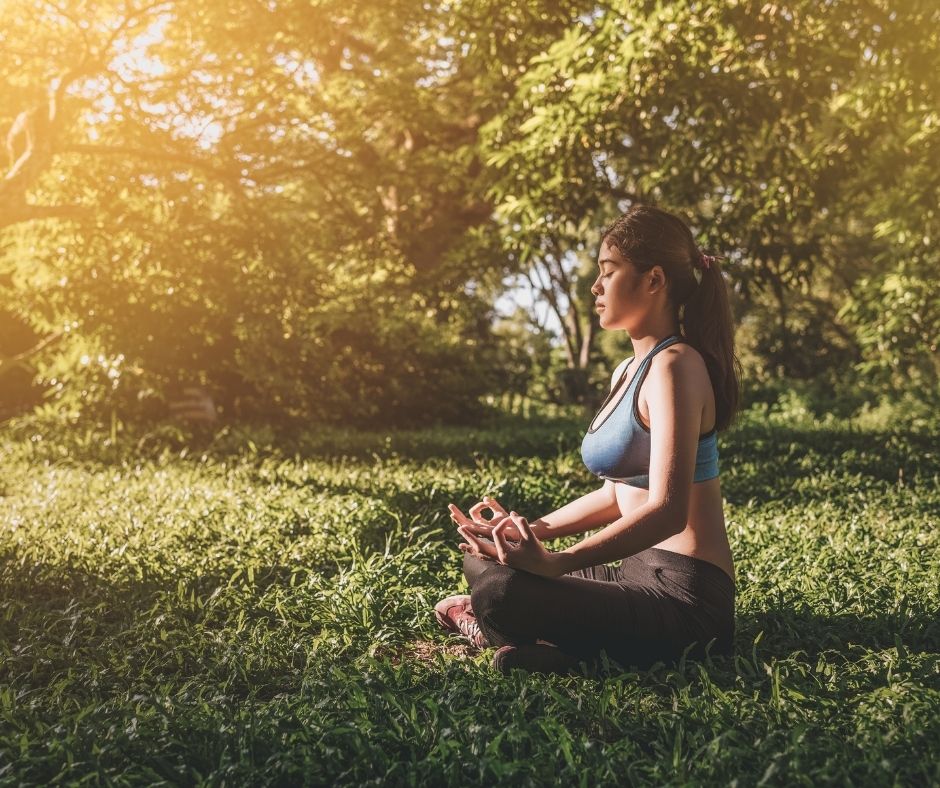“Mindfulness” might sound like something that’s only for yogis or people with a lot of free time and resources. However, it’s actually something that is accessible to anyone who is willing to try it and an important part of the program at Aldea.
Research shows that mindfulness has numerous benefits for your physical and mental health, so today we’ll dive into what it is, how to do it, and how it could help you live a more fulfilling life.
What is Mindfulness?
Jon Kabat-Zinn, author and founder of the Center for Mindfulness and the Stress Reduction Clinic at the University of Massachusetts, defines mindfulness as “awareness that arises through paying attention, on purpose, in the present moment, and non-judgmentally.”
In other words, mindfulness is taking the time to notice how you feel, the thoughts that come up, and what’s happening around you without labeling any of it as “good” or “bad” but just accepting what is. This practice helps you to not only be better at dealing with life’s stressors but also to be more fully present and appreciate all the joy and beauty around you.

Mindfulness vs. Meditation
These terms can be confusing because they are often used interchangeably but they are not the same.
Mindfulness is a state of being fully present and engaged in the moment without judgement.
Meditation is a formal practice, often involving breath, that can be used to cultivate mindfulness and focus.
Think of mindfulness more as a way of life, something that you can incorporate into your everyday tasks such as eating, walking, even washing the dishes or having a conversation.
Meditation, on the other hand, requires setting aside some time to sit quietly and use a combination of mental and physical techniques to focus, clear, or “quiet” your mind.
Both have myriad health benefits and can make a positive impact on your wellbeing. At the end of the blog we’ll share some resources on meditation if you’re interested in learning more.
But I don’t have time for mindfulness!

It’s important to note that there are many, many ways to practice mindfulness, from taking a minute to focus on your breathing to attending a weekend meditation retreat and everything in between. Once you understand the basics of mindfulness, you can put it into practice whenever, wherever.
It doesn’t have to take up a lot of time, and you don’t need anything special to practice it. That’s one of the wonderful things about mindfulness and what makes it accessible to all kinds of people.
Later on we’ll share some ways you can incorporate mindfulness into your everyday life.
What are the benefits of mindfulness?
According to the American Psychological Association, research on mindfulness has identified the following benefits:
- Stress reduction
- Less rumination
- Rumination is repetitive thinking or dwelling on negative feelings and distress. In other words, feeling stuck in a cycle of negative thoughts.
- Improved working memory
- Better focus
- Less emotional reactivity
- Relationship satisfaction

As if that weren’t enough, mindfulness can also have a positive impact on your physical health. Clinical research suggests that mindfulness can:
- Improve sleep
- Improve high blood pressure
- Help manage your diabetes
In recent years science has shown how chronic stress negatively impacts our health and wellbeing. Stress can lead to high blood pressure, stroke, heart disease, obesity, and more.
Because mindfulness is effective for reducing stress, learning how to live in a more mindful way goes a long way to preventing serious health complications.
Easy ways to incorporate mindfulness into everyday life
As we said before, living a more mindful life doesn’t require a lot of money or time. You can put mindfulness into practice at literally any time of the day. Next time you’re doing a repetitive or “mindless” task, simply pay attention to what you’re doing.
Feel the warm water on your hands and smell the soap while you’re washing the dishes. Look into your children’s eyes and really listen to their words next time they talk to you. Notice the birds chirping and the wind on your face as you hang up the laundry.
There is beauty in the world around you. You don’t have to pay for a vacation or go to a fancy spa to enjoy your life. Cultivating mindfulness helps you tune in to the extraordinary things that often go unnoticed.
Here are some ways you can incorporate mindfulness into the everyday:
Mindful Eating

You have to eat at least three times a day, so why not use the opportunity to cultivate mindfulness? In our fast-paced lives, we tend to eat quickly without paying much attention to what we’re putting in our mouths. Most of us don’t even chew our food properly, which can cause digestive problems.
This simple exercise helps you focus on what you’re eating and can even increase satisfaction with your food.
- Next time you sit down to eat, before you even lift the fork to your mouth take time to observe your food.
- What does it smell like?
- What does it look like?
- How are you feeling about eating it?
- What emotions come up when you sit down to eat a meal?
- Take a moment to feel gratitude that you have food to eat.
- When you put the first bite into your mouth, chew slowly and thoughtfully.
- Notice the texture and taste of the food.
- Notice your emotions and thoughts.
- If you’ve dieted a lot in your life, you probably have some negative emotions and thoughts around food. Don’t try to push them away, just let them come and observe them without judgement.
- As you eat, savor each bite.
- Try to be in tune with your hunger cues. Notice what your body is telling you about how much food you need to eat. Don’t feel pressured to finish everything on your plate.
- Stop when you feel full.
Mindful Pause
Throughout the day, check in with yourself and your thoughts and feelings. If you’re overwhelmed or stressed, take a few moments to breathe. Tune into yourself and your surroundings. Close your eyes and notice the sounds and smells around you. Notice your heartbeat, how you’re feeling in your body.
Even just a minute of this kind of intentional self-observation can make a big difference in your mood and how you feel the rest of the day.
Mindfulness in Your Interactions with Others

Our increasing use of social media and smartphones has made it more common for our interactions with each other to be distracted and disjointed. How often do we interrupt a face-to-face interaction to check our phones?
Bringing mindfulness to your interactions with the people around you is a great way to improve your mood and help you get along with others with less judgement.
You can apply this awareness to all of your social interactions, not just those with close friends and family. When you are paying for something at the grocery store, put your phone away and take a moment to really engage with the cashier. Even if you don’t feel like having a full conversation with them, greet them and thank them with genuine intention.
Mindful Driving

Driving can be stressful, especially if you’re running late or get stuck in traffic. Bringing mindfulness to your experience on the road can help reduce stress and make you a better driver.
If you feel yourself getting upset or anxious behind the wheel, tune into emotions and your surroundings. Put your phone away. Notice the cars and drivers around you. Try to observe them without judgement. Remember that you don’t know what they are thinking or feeling. Give other drivers the benefit of the doubt. If someone is rude, maybe they just lost their job or are on their way to visit a sick loved one in the hospital.
Practice compassion, empathy, and attention behind the wheel. You might find that driving mindfully helps you actually look forward to your commute!
Start small and commit

Living a more mindful life is a journey, and you won’t feel the positive effects overnight. While some research suggests that as little as 8 weeks of mindfulness or meditation practice has demonstrable benefits, don’t get discouraged if you don’t notice a change right away.
It’s important not to set your sights too high. Start with small, achievable goals. Commit to having a mindful cup of coffee every morning, or five minutes of mindful breathing before you go to bed at night for a month.
There are lots of guided mindfulness exercises available online as well. Googling “guided mindfulness” or “guided meditations” is a great way to start.
The research is clear about the benefits of mindfulness, the challenge is finding something that works for you.
Find a community to encourage your efforts
We are social creatures, and having a supportive community is a great way to cultivate healthy habits such as mindfulness.
If you live in Austin, TX, there are many resources for affordable mental health activities and classes.
If you’re a Spanish-speaking woman in Austin who wants to cultivate mindfulness and empowerment with professional guidance and a supportive community of women, you could be a great candidate for our transformational wellness program. For more information, contact us or fill our evaluation to start the registration process.
Learn More About Meditation
Mindfulness vs Meditation: 5 Crucial Differences
10 health benefits of meditation and how to focus on mindfulness
Sources
American Psychological Association: What Are the Benefits of Mindfulness
Harvard Health Publishing: Evoking calm: Practicing mindfulness in daily life helps
Mayo Clinic: Mindfulness Exercises
University of Minnesota: What is Mindfulness?
The Harvard Gazette: When science meets mindfulness
Meditation and Mindfulness in Austin
Bilingual Yoga4Stress Relief at the Southeast Health and Wellness Center

